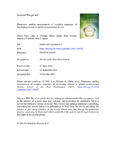Phenomics enables measurement of complex responses of developing animals to global environmental drivers
| dc.contributor.author | Feistel, Susanne | |
| dc.contributor.author | Holmes, LA | |
| dc.contributor.author | Quinn, E | |
| dc.contributor.author | Everett, T | |
| dc.contributor.author | Truebano, M | |
| dc.contributor.author | Spicer, John | |
| dc.date.accessioned | 2022-11-03T14:08:16Z | |
| dc.date.issued | 2022-10-23 | |
| dc.identifier.issn | 1879-1026 | |
| dc.identifier.issn | 1879-1026 | |
| dc.identifier.other | 159555 | |
| dc.identifier.uri | http://hdl.handle.net/10026.1/19836 | |
| dc.description.abstract |
Phenomics offers technological advances for high-dimensional phenotyping, facilitating rapid, high-throughput assessment of physiological performance and has proven invaluable in global research challenges including drug discovery and food security. However, this rapidly growing discipline has remained largely inaccessible to the increasingly urgent challenge of assessing organismal functional sensitivity to global change drivers. Here, we investigate the response of an ecologically important marine invertebrate to multiple environmental drivers using Energy Proxy Traits (EPTs), a new approach for measuring complex phenotypes captured on video as a spectrum of energy levels across different temporal frequencies in fluctuating pixel values. We imaged three developmental stages of the common prawn Palaemon serratus at different salinities and temperatures, and measured EPTs and heart rate, a major proxy of physiological performance in ectotherms present across stages. Significant interactions were detected between temperature, developmental stage and salinity in frequency-specific energy levels. Despite cardiac activity being a significant contributor to the EPT spectra, treatment interactions were different from those observed on EPTs, highlighting additional phenotypic drivers of EPTs. Elevated temperature resulted in a shift of the EPT spectra towards higher frequency signals, indicating a reallocation of resources within the phenome. Using a non-linear dimensionality reduction, we interrogated the responses of EPT spectra in high-dimensional space. We discovered complex developmental-stage specific sensitivities, highlighting both the complexity of phenotypic responses, and the limits of using univariate approaches with pre-selected traits to assess responses to multiple global environmental drivers. EPTs are a high-dimensional, transferrable method of phenotyping, and are therefore highly relevant to addressing the current limitations of traditional methods of phenotyping applied to assessing biological sensitivity to drivers of global change. We predict that EPTs will become an important tool for indiscriminate phenotyping, transferrable between species, developmental stages and experimental designs. | |
| dc.format.extent | 159555-159555 | |
| dc.format.medium | Print-Electronic | |
| dc.language | en | |
| dc.language.iso | eng | |
| dc.publisher | Elsevier | |
| dc.subject | Multistressor | |
| dc.subject | Phenomics | |
| dc.subject | Prawn | |
| dc.subject | Thermal biology | |
| dc.subject | Stress biology | |
| dc.subject | Developmental physiology | |
| dc.title | Phenomics enables measurement of complex responses of developing animals to global environmental drivers | |
| dc.type | journal-article | |
| dc.type | Journal Article | |
| plymouth.author-url | https://www.webofscience.com/api/gateway?GWVersion=2&SrcApp=PARTNER_APP&SrcAuth=LinksAMR&KeyUT=WOS:000907567800005&DestLinkType=FullRecord&DestApp=ALL_WOS&UsrCustomerID=11bb513d99f797142bcfeffcc58ea008 | |
| plymouth.issue | Pt 2 | |
| plymouth.volume | 858 | |
| plymouth.publication-status | Published | |
| plymouth.journal | Science of the Total Environment | |
| dc.identifier.doi | 10.1016/j.scitotenv.2022.159555 | |
| plymouth.organisational-group | /Plymouth | |
| plymouth.organisational-group | /Plymouth/Faculty of Science and Engineering | |
| plymouth.organisational-group | /Plymouth/Faculty of Science and Engineering/School of Biological and Marine Sciences | |
| plymouth.organisational-group | /Plymouth/REF 2021 Researchers by UoA | |
| plymouth.organisational-group | /Plymouth/REF 2021 Researchers by UoA/UoA07 Earth Systems and Environmental Sciences | |
| plymouth.organisational-group | /Plymouth/Users by role | |
| plymouth.organisational-group | /Plymouth/Users by role/Academics | |
| plymouth.organisational-group | /Plymouth/Users by role/Researchers in ResearchFish submission | |
| dc.publisher.place | Netherlands | |
| dcterms.dateAccepted | 2022-10-14 | |
| dc.rights.embargodate | 2022-11-4 | |
| dc.identifier.eissn | 1879-1026 | |
| dc.rights.embargoperiod | Not known | |
| rioxxterms.versionofrecord | 10.1016/j.scitotenv.2022.159555 | |
| rioxxterms.licenseref.uri | http://www.rioxx.net/licenses/all-rights-reserved | |
| rioxxterms.licenseref.startdate | 2022-10-22 | |
| rioxxterms.type | Journal Article/Review |


